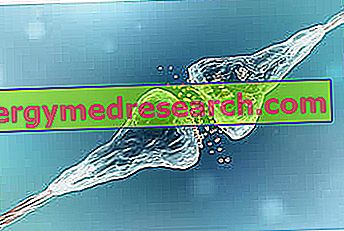Generality
Neurotransmitters are endogenous chemical messengers, which are used by the cells of the nervous system (so-called neurons) to communicate with each other or to stimulate muscle or glandular cells.

Chemical synapses are sites of functional contact between two neurons or between a neuron and another kind of cell.
There are various classes of neurotransmitters: the class of amino acids, the class of monoamines, the class of peptides, the class of "trace" amines, the class of purines, the class of gases etc.
The most well-known neurotransmitters include: dopamine, acetylcholine, glutamate, GABA and serotonin.
What are neurotransmitters?
Neurotransmitters are chemicals, which are used by neurons - the cells of the nervous system - to communicate with each other, to act on muscle cells or to stimulate a response from glandular cells.
In other words, neurotransmitters are endogenous chemical messengers, which allow interneuronal communication (ie between neurons) and communication between neurons and the rest of the body.
The human nervous system uses neurotransmitters to regulate or direct vital mechanisms, such as heart rate, lung breathing or digestion.
Furthermore, night-time sleep, concentration, mood, etc. depend on neurotransmitters.
NEUROTRANSMITTERS AND CHEMICAL SYNAPSIS
According to a more specialized definition, neurotransmitters are the carriers of information along the system of so-called chemical synapses .
In neurobiology, the term synapse (or synaptic junction) indicates the sites of functional contact between two neurons or between a neuron and another kind of cell (for example a muscle cell or a glandular cell).
The function of a synapse is to transmit information between the cells involved, to produce a certain response (for example the contraction of a muscle).
The human nervous system includes two types of synapses:
- The electrical synapses, in which the communication of information depends on a flow of electric currents through the two cells involved, e
- The aforementioned chemical synapses, in which the communication of information depends on a flow of neurotransmitters through the two cells involved.
A classic chemical synapse consists of three fundamental components, placed in series:
- The pre-synaptic terminal of the neuron from which nerve information originates. The neuron in question is also called the pre-synaptic neuron ;
- The synaptic space, ie the space of separation between the two cells that are the protagonists of the synapse. It resides outside cell membranes and has an extension area of about 20-40 nanometers;
- The post-synaptic membrane of the neuron, of the muscle cell or of the glandular cell to which nerve information must reach. Whether it is a neuron, a muscle cell or a glandular cell, the cellular unit to which the post-synaptic membrane belongs is called a post-synaptic element .
The chemical synapse that unites a neuron to a muscle cell is also known as a neuromuscular junction or motor plate .
DISCOVERY OF NEUROTRANSMITTERS

Figure: chemical synapse
Until the early years of the twentieth century, scientists believed that communication between neurons and between neurons and other cells occurred exclusively through electrical synapses.
The idea that another mode of communication could exist arose when some researchers discovered the so-called synaptic space.
The German pharmacologist Otto Loewi hypothesized that the synaptic space could be used by neurons to release chemical messengers. It was the year 1921.
Through his experiments on the nervous regulation of cardiac activity, Loewi became the protagonist of the discovery of the first known neurotransmitter: acetylcholine .
seat
In pre-synaptic neurons, neurotransmitters reside within small intracellular vesicles .
These intercellular vesicles are comparable to sacs, delimited by a double layer of phospholipids similar, in various aspects, to the double phospholipid layer of the plasma membrane of a generic healthy eukaryotic cell.
As long as they remain within the intracellular vesicles, the neurotransmitters are so to speak inert and produce no response.
Action mechanism
Premise: to understand the mechanism of action of neurotransmitters it is good to have in mind the chemical synapses and their composition, described previously.
The neurotransmitters remain confined within the intracellular vesicles, until a signal of nerve origin capable of stimulating the release of the vesicles from the container neuron arrives.
The release of the vesicles takes place near the pre-synaptic terminal of the container neuron and involves the release of neurotransmitters in the synaptic space.
In the synaptic space, the neurotransmitters are free to interact with the post-synaptic membrane of the nerve, muscle or glandular cell, located in the immediate vicinity and forming part of the chemical synapse.
The interaction between neurotransmitters and post-synaptic membrane is possible thanks to the presence, on the latter, of particular proteins, properly called membrane receptors .
The contact between the neurotransmitters and the membrane receptors turns the initial nerve signal (the one that stimulated the release of intracellular vesicles) into a well-specific cellular response. For example, the cellular response produced by the interaction between neurotransmitters and the post-synaptic membrane of a muscle cell may consist in the contraction of the muscle tissue to which the aforementioned cell belongs.
At the conclusion of this schematic picture of how neurotransmitters work, it is important to report the following last aspect: the specific cellular response mentioned above depends on the type of neurotransmitter and the type of receptors present on the post-synaptic membrane.
WHAT IS THE ACTION POTENTIAL?
In neurobiology, the nerve signal that stimulates the release of intracellular vesicles is called action potential .
By definition, the action potential is that phenomenon which takes place in a generic neuron and which foresees a rapid change in electrical charge between the inside and the outside of the cell membrane of the involved neuron.
In light of this, it is not surprising when, talking about nerve signals, experts compare them to electrical impulses: a nervous signal is an electrical event in all respects.
CHARACTERISTICS OF THE CELLULAR RESPONSE
According to the language of neurobiologists, the cellular response induced by neurotransmitters, at the level of the post-synaptic membrane, can be excitatory or inhibitory .
An excitatory response is a reaction to promote the creation of a nerve impulse in the post-synaptic element.
An inhibitory response, on the other hand, is a reaction designed to inhibit the creation of a nerve impulse in the post-synaptic element.
Classification
The human neurotransmitters known are very numerous and their list is destined to grow, since, regularly, neurobiologists discover new ones.
The large number of recognized neurotransmitters has made the classification of these chemical molecules indispensable, so as to simplify consultation.
There are various classification criteria; the most common is the one that distinguishes neurotransmitters based on the class of molecules they belong to .
The main classes of molecules to which human neurotransmitters belong are:
- The class of amino acids or amino acid derivatives . This class includes: glutamate (or glutamic acid), aspartate (or aspartic acid), gamma-aminobutyric acid (better known as GABA) and glycine.
- The class of peptides . This class includes: somatostatin, opioids, substance P, some secretins (secretin, glucagon, etc.), some tachykinins (neurokinin A, neurokinin B, etc.), some gastrins, galanin, neurotensin and so-called cocaine-regulated transcripts amphetamine.
- The class of monoamines . This class includes: dopamine, norepinephrine, epinephrine, histamine, serotonin and melatonin.
- The class of the so-called " amine trace ". This class includes: tyramine, tri-iodothyronamine, 2-phenylethylamine (or 2-phenylethylamine), octopamine and tryptamine (or triptamine).
- The class of purines . This class includes: adenosine triphosphate and adenosine.
- The gas class. This class includes: nitric oxide (NO), carbon monoxide (CO) and hydrogen sulfide (H2S).
- Other . All the neurotransmitters that cannot be inserted in any of the previous classes, such as the already mentioned acetylcholine or anandamide, fall under the heading "other".
Best known examples
Some neurotransmitters are decidedly more famous than others, both because they have been known and studied for longer, and because they perform functions of considerable biological interest.
Among the most famous neurotransmitters they deserve a mention:
- Glutamate . It is the main excitatory neurotransmitter of the central nervous system: according to what neurobiologists say, more than 90% of the so-called excitatory synapses would be used.Alongside its excitatory function, glutamate is also involved in learning processes (learning as a process of storing data in the brain) and memory.
According to some scientific studies, it would be implicated in diseases such as: Alzheimer's disease, Huntington's disease, amyotrophic lateral sclerosis (better known as ALS) and Parkinson's.
- The GABA . It is the main inhibitory neurotransmitter of the central nervous system: according to the latest biology studies, about 90% of the so-called inhibitory synapses would be used.
Due to its inhibitory properties, GABA is one of the main targets of sedative and tranquilizer drugs.
- Acetylcholine . It is a neurotransmitter with an excitatory function on the muscles: in the neuromuscular junctions, in fact, its presence sets in motion those mechanisms that contract the cells of the affected muscle tissues.
In addition to acting on a muscular level, acetylcholine also influences the functioning of the organs controlled by the so-called autonomic nervous system. Its influence in the autonomic nervous system can be both excitatory and inhibitory.
- Dopamine . Belonging to the catecholamine family, it is a neurotransmitter that performs numerous functions, both in the central nervous system and in the peripheral nervous system.
At the level of the central nervous system, dopamine participates in: movement control, prolactin hormone secretion, control of motor skills, reward and pleasure mechanisms, attention span control, sleep mechanism, the behavior control, control of some cognitive functions, mood control and, finally, the mechanisms underlying learning.
At the level of the peripheral nervous system, however, it acts as: vasodilator, stimulating sodium excretion, a factor favoring intestinal motility, a factor that reduces lymphocyte activity and, finally, a factor that reduces insulin secretion.
- Serotonin . It is a neurotransmitter found mainly in the intestine and, although to a lesser extent than in the intestine, in the neurons of the central nervous system.
By its inhibitory effects, serotonin would seem to regulate appetite, sleep, memory and learning processes, body temperature, mood, some aspects of behavior, muscle contraction, some functions of the cardiovascular system and some functions of the endocrine system .
From a pathological point of view, it would seem to have a role in the development of depression and related diseases. This explains the existence on the market of the so-called selective serotonin reuptake inhibitors, antidepressant drugs used for the treatment of more or less serious depressive forms.
- Histamine . It is a neurotransmitter prevalently located in the central nervous system, precisely at the level of the hypothalamus and mast cells present in the brain and spinal cord.
- Norepinephrine and epinephrine . Norepinephrine concentrates mainly at the level of the central nervous system and has the task of mobilizing the brain and body for action (it therefore has an excitatory effect). For example, in the brain, it promotes excitement, alertness, concentration and memory processes; in the rest of the body, it increases heart rate and blood pressure, stimulates the release of glucose from storage points, increases blood flow to the skeletal muscles, reduces blood flow to the gastrointestinal system and promotes bladder and bowel emptying.
Epinephrine is present, to a large extent, in adrenal gland cells and, in small quantities, in the central nervous system.
This neurotransmitter has excitatory effects and participates in processes such as: increased blood to skeletal muscles, increased heart rate and pupil dilation.
Both norepinephrine and epinephrine are neurotransmitters derived from tyrosine.



